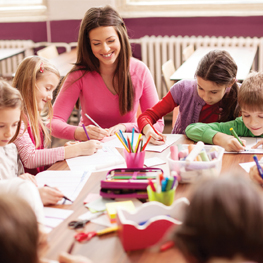
It’s been more than 100 years since Dr. Maria Montessori began working with children, but her life’s work and legacy has transformed our understanding of children and how they engage with the world around them. Today, accredited Montessori schools around the world, staffed with Montessori-certified educators called 'guides', continue Dr. Montessori’s work. They strive to support the whole child, helping children at all stages of development become capable, independent, collaborative learners. Over a century later, her life’s work and philosophy help us understand how children are the key to a more peaceful world. What makes Montessori education more vital and important than ever?
Problem-solving and creative thinking
Through a process of scientific observation, Dr. Montessori designed specialized materials to help children learn core concepts, such as addition in mathematics or patterns of language. Today, in carefully- prepared learning environments and supported by their guides, children learn abstract ideas and are able to solve problems with materials that prompt self-correction. This exploration of concrete materials allows them to reach a deeper level of understanding and approach the world with deliberate curiosity.
The Montessori curriculum helps build human connections, philanthropy, and an understanding that we are all interconnected and interdependent. Alongside the material, the guides implement the curriculum. Beginning with the great lessons, establishing the framework for all subsequent lessons, children are inspired to learn and explore the world and all its people. This helps to build gratitude and a sense of wonder for all that humankind has discovered and created, and for all that we continue to discover and create.
Time and space
Montessori believed children needed to have a generous amount of uninterrupted time to work with the materials. In Montessori schools today, this means a three-hour work cycle, allowing for children to ebb and flow through concentrated work, and give enough time for reflection or the opportunity to discover the concepts in the material, or to find new work. During this time, the guide gives lessons to individual or small groups of students or makes observations of what work the children are doing, which is then used to build lesson-planning. Formative assessment occurs daily in a Montessori classroom.
Independence and self-awareness
The prepared environment fosters a space where children are empowered to do things for themselves. All items in the environment are scaled to the child’s size, including furniture, shelves, utensils, dish-ware, cleaning tools, as well as the Montessori materials. There is no focal centre to the classroom as the teacher is not the focus of the children. Rather, the young children interact with the environment, together as one community.
Unlike a traditional classroom where the teacher teaches one lesson to the entire class, in a Montessori classroom, the teacher bases lessons on the needs of the individual student. This allows for children in a Montessori classroom to develop further in their areas of weakness through targeted lessons and gives them freedom to continue to build upon their strengths. The students have the choice to work on a project that is of interest, but the guide ensures that all curriculum or learning outcomes are met.
Knowledge-transfer and collaboration
A Montessori classroom intentionally allows for greater collaboration and social learning as an integral component to the learning process. Children in a Montessori classroom are taught how to regulate their own social interactions and experience the freedom to learn how to negotiate, share, mediate, and compromise. The result is a self-regulating classroom in which natural social tensions are resolved primarily by the children themselves, with the guidance of the Montessori guide.
Another significant difference between a Montessori classroom and a traditional classroom is the multi-age groupings spanning three years. This allows for mentorship and leadership development and opportunities, and for children to be taught in mixed age learning groups, depending on their readiness. The mixed age group allows for younger children to look up to older peers for help and inspiration.
Dr. Montessori recognized the potential within every child. Through her work, children continue to flourish, reaching their highest potentials and find their own place in the world.
Lifelong educators, Stamatina is an Elementary Guide, and Patti is Head of School at Montessori School of Calgary where they partner with parents and family to ensure the success of the whole child. The Montessori School of Calgary is located at 2201 Cliff Street SW. For more information, visit montessorischoolofcalgary.com.
Calgary’s Child Magazine © 2024 Calgary’s Child